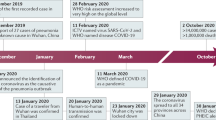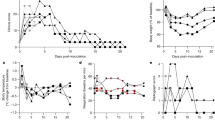Abstract
Severe acute respiratory syndrome (SARS) has recently emerged as a new human disease, resulting globally in 435 deaths from 6,234 probable cases (as of 3 May 2003). Here we provide proof from experimental infection of cynomolgus macaques (Macaca fascicularis) that the newly discovered SARS-associated coronavirus (SCV) is the aetiological agent of this disease. Our understanding of the aetiology of SARS will expedite the development of diagnostic tests, antiviral therapies and vaccines, and may allow a more concise case definition for this emerging disease.
Similar content being viewed by others
Main
According to Koch's postulates, as modified by Rivers for viral diseases, six criteria are required to establish a virus as the cause of a disease1. The first three criteria — isolation of virus from diseased hosts, cultivation in host cells, and proof of filterability — have been met for SCV by several groups2,3,4,5. Moreover, of 96 individuals complying with the World Health Organization's definition of SARS6 in Hong Kong, 86 (90%) yielded laboratory evidence of SCV infection.
We have tested for the three remaining criteria: production of comparable disease in the original host species or a related one, re-isolation of the virus, and detection of a specific immune response to the virus. We inoculated two macaques with Vero-cell-cultured SCV isolated from a fatal SARS case, and monitored their clinical signs, virus excretion and antibody response. The animals were killed six days post-inoculation (d.p.i.), and we then carried out gross and histopathological examinations of them.
Both SCV-inoculated macaques became lethargic from 3 d.p.i. onwards and developed a temporary skin rash, and one suffered respiratory distress from 4 d.p.i. onwards. The macaques excreted virus from the nose and throat at 2–6 d.p.i., as shown by polymerase chain reaction with reverse transcription (RT-PCR) and by virus isolation (see supplementary information). The isolated virus was identical to that inoculated, as shown by negative-contrast electron microscopy (Fig. 1a) and RT-PCR analysis. Seroconversion to SCV, as determined by indirect immunofluorescence assay using infected Vero cells, was demonstrated in two other SCV-infected macaques at 16 d.p.i.. The virus was also isolated from the faeces of one of these animals (see supplementary information).
a, Virus particles re-isolated from nasal swabs of infected macaques display typical coronavirus morphology. b, Diffuse alveolar damage in the lung; alveoli are flooded with highly proteinaceous fluid (arrowhead) that stains dark pink. c, Several syncytia (arrowheads) are present in the lumen of a bronchiole and surrounding alveoli. Original magnifications: a, ×200,000; b, ×150; c, ×100.
At gross necropsy, one macaque had severe multifocal pulmonary consolidation, and SCV infection was detected in lung tissue by RT-PCR and virus isolation. Histologically, both macaques had interstitial pneumonia of differing severity. The one with gross lesions had diffuse alveolar damage, marked by necrosis of alveolar and bronchiolar epithelium and flooding of alveolar lumina with proteinaceous fluid, admixed with fibrin, erythrocytes, alveolar macrophages and neutrophils (Fig. 1b). Occasional multinucleated cells (syncytia) were present in the lumen of bronchioles and alveoli (Fig. 1c). These lesions are indistinguishable from those in biopsied lung tissue and in autopsy material from SARS patients5, including the presence of syncytia in alveolar lumina4.
SCV thus fulfils all of Koch's postulates as the primary aetiological agent of SARS. This does not exclude the possibility that other pathogens, including human metapneumovirus (hMPV) and Chlamydia pneumoniae, may have exacerbated the disease in some SARS patients. However, these were not present in SCV-inoculated macaques (results not shown), were not found consistently in SARS patients, and do not usually cause the lesions associated with SARS. Moreover, lesions in macaques infected experimentally with hMPV isolated from a non-SARS individual7 were limited to mild suppurative rhinitis and minimal erosion in conducting airways, and disease was not exacerbated in two SCV-infected macaques subsequently inoculated with hMPV (results not shown).
References
Rivers, T. M. J. Bacteriol. 33, 1–12 (1937).
Poutanen, S. M. et al. N. Engl. J. Med. (in the press).
Drosten, C. et al. N. Engl. J. Med. (in the press).
Ksiazek, T. G. et al. N. Engl. J. Med. (in the press).
Peiris, J. S. M. et al. Lancet 361, 1319–1325 (2003).
Wkly Epidemiol. Rec. 78, 81–83 (2003).
van den Hoogen, B. G. et al. Nature Med. 7, 719–724 (2001).
Author information
Authors and Affiliations
Corresponding author
Ethics declarations
Competing interests
The authors declare no competing financial interests.
Supplementary information
Rights and permissions
About this article
Cite this article
Fouchier, R., Kuiken, T., Schutten, M. et al. Koch's postulates fulfilled for SARS virus. Nature 423, 240 (2003). https://doi.org/10.1038/423240a
Issue Date:
DOI: https://doi.org/10.1038/423240a
This article is cited by
-
Study Protocol of a Randomized Controlled Clinical Trial to Evaluate the Efficacy and Safety of Ropeginterferon Alfa-2b in COVID-19 Patients with Comorbidities
Advances in Therapy (2024)
-
An Overview on the Zoonotic Aspects of COVID-19
Proceedings of the National Academy of Sciences, India Section B: Biological Sciences (2024)
-
Identification of FDA-approved drugs against SARS-CoV-2 RNA-dependent RNA polymerase (RdRp) through computational virtual screening
Structural Chemistry (2023)
-
In vitro screening of anti-viral and virucidal effects against SARS-CoV-2 by Hypericum perforatum and Echinacea
Scientific Reports (2022)
-
Origin, Pathogenesis, Diagnosis and Treatment Options for SARS-CoV-2: A Review
Biologia (2021)




